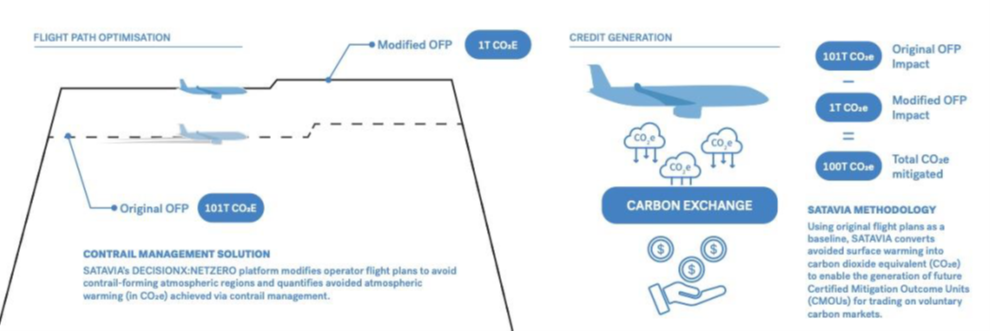
With the aviation sector accounting for around 2.5% of global CO2 emissions, developing smarter and greener practices for airlines and associated industries is both a major challenge and a global imperative. As part of the European Space Agency’s Business Applications and Space Solutions (BASS) programme and supported by the UK Space Agency (UKSA), UK green aerospace company SATAVIA has successfully completed a Demonstration Project involving contrail management trials with multiple airlines. The atmospheric modelling platform developed in the project has the potential to significantly reduce the impact of air travel on the environment.
In 2021, the United Nations IPCC Climate Impact Report stated that aviation’s non-CO2 climate impacts constituted a highly significant component of the sector’s overall climate footprint, largely due to the creation of aircraft condensation trials (contrails). Contrails form at high altitudes when water vapour from aircraft engine exhaust freezes into ice crystals. Contrails mostly dissipate quickly, but in some conditions they can persist for many hours. These contrails can trap heat from the Earth, especially at night when sunlight is absent, thus contributing to atmospheric global warming. Using a conservative metric (GWP100), aircraft contrails account for more than half the climate impact of aviation’s CO2 footprint.
The SATAVIA DECISIONX:NETZERO project saw an evolution of the company’s core DECISIONX technology, developed under an earlier project with ESA BASS, which used airborne contaminant, satellite and aircraft datasets to optimise jet engine maintenance cycles (leading to potential for 9% increase in time-on-wing and saving up to $55K per aircraft per year). Building on this core technology, SATAVIA coupled numerical weather prediction modelling with per-flight contrail climate impact modelling. This approach enables the identification of individual flights which are likely to form persistent warming contrails, in turn enabling navigational avoidance and climate benefit calculations. Leveraging this technological capability, the project set out to demonstrate that contrail management is operationally possible and offers credible non-CO2 climate impact savings.

SATAVIA engaged twelve airlines including Condor, Icelandair, and SunExpress for the next stage of the project, deploying its sophisticated atmospheric modelling technology to optimise 65 flights for contrail management. The technology was able to identify airspace where warming persistent contrails are most likely to form and, as a consequence, optimise flight plans in real time to prevent this taking place. These trials saw an average reduction in non-CO2 climate impact of >40 tonnes of carbon dioxide equivalent (T/CO2e) per optimised flight, with a total prevented climate impact of more than 2,200 T/CO2e in total. Interestingly, this flight optimisation saw minimal impact upon flight times and fuel consumption, especially during long haul flights.
“The trials conducted during the project were very positive. All the airlines involved took this project very seriously throughout and the funding from ESA made it possible for SATAVIA to engage a larger number of airlines, resulting in a wider data range,” said Arnaud Runge, Technical Officer at the European Space Agency, who also holds an airline pilot license. “The trials were vital in highlighting how space technologies can support the environmental efforts being made in aviation, at a challenging time for the sector.”

Dr Craig Brown, Director of Investment at the UK Space Agency, said: “We know that aviation is a key contributor to carbon emissions, so it’s vital to explore how technologies such as greener fuels can address this. The results from the DECISIONX trials – which used ESA’s Earth observation data for atmospheric modelling – demonstrate how fundamental the use of space is to this global ambition. SATAVIA’s technology could make a significant impact on the voluntary carbon market, boosting opportunities for aviation sector investment in the UK, while supporting major industry initiatives against climate change.”
For the first time in the sector, 2025 will see the introduction of mandatory monitoring, reporting, and verification (MRV) of aviation’s non-CO2 impacts (including contrails) under the European Union Emission Trading Scheme (EU ETS), as the commercial aviation sector looks to mitigate the damaging effects of contrails, soot, nitrous oxides, and other non-CO2 effects. By the end of 2027, the European Commission will also submit a report that may lead to mandatory contrail avoidance within relevant territories. Alongside these policy developments, SATAVIA has patented a new methodology to generate future voluntary carbon credits from contrail management and provide financing for contrail management in advance of regulation. The method is currently undergoing design certification with Gold Standard, following concept approval in August 2023, and – once approved – will help to scale contrail management across commercial aviation.
Dr Adam Durant, who founded SATAVIA in 2013, said “This new voluntary carbon market will be worth billions of dollars globally, creating a bottom-line rationale for operators to cut their non-CO2 climate footprint in the absence of regulation. As a low-cost, easy-to-implement software solution, contrail management can help move aviation towards climate-neutral operation on near-term timescales. UKSA and ESA support for action on contrails is driving progress in this hard-to-abate industry.”
Looking to the future, SATAVIA aims to build on the success of this ESA BASS project with further R&D activity, including via collaborations with air navigation service providers (ANSPs) to identify challenges and opportunities for scaling contrail management within routine commercial aviation.


